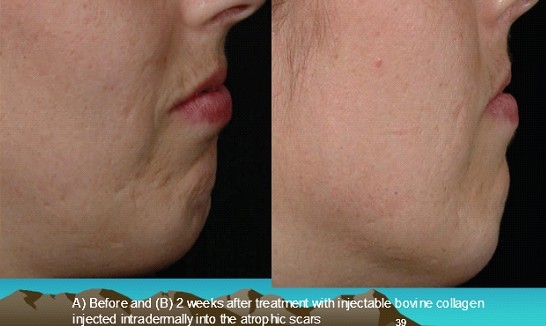.jpg)
站内搜索
热点信息
当前位置:首页 > 海悦生物 > 病因病理
Cause of ACNE SCAR (2)发布时间:2013-08-01 阅读:次 [打印文章] [关闭窗口]
Fillers and fat transfer for treatment of acne scarring
Better used in atrophic depressed scarsAgent include – Collagens, Zyderm, Zyplast, Cosmoderm, Cosmoplast, Evdence and Evdence Breeze are all collagensHyaluronic Acids, Calcium hydroxyapatiteFat TransplantationFat transfer can be helpful in acne scarring by restoring the loss of subcutaneous fat and replacing volume, which stretches and overlying skin and distends the acne scars. Patients who are particularly good candidates for fat transplantation include the acne-scarred patient who has a thin, atrophic face.Many of these older patient can benefit from a pan-facial lipoaugnebtation concurrent with the specific injections designed to minimize the acne scarring
 Needling – useful technique for acne scars treatment as an alternative to laser, chemical peelings an DermabrasionInduction of new dermal collagen synthesis and deposition. By activation of a local inflammatory response.The stratum corneum remain intactThere are no risks of hyperpigmentationThe healing phase is short and the treatment can be repeatedMethodSkin needling is a procedure that involves using a sterile roller comprised of a series of fine sharp needles to puncture the skin. Performed under local anaesthetic with sedation , the device is “rolled” over the surface affected by acne scars to create many microscopic channels deep into the dermis of the skin, which stimulates your own body to produce new collagen.
Needling – useful technique for acne scars treatment as an alternative to laser, chemical peelings an DermabrasionInduction of new dermal collagen synthesis and deposition. By activation of a local inflammatory response.The stratum corneum remain intactThere are no risks of hyperpigmentationThe healing phase is short and the treatment can be repeatedMethodSkin needling is a procedure that involves using a sterile roller comprised of a series of fine sharp needles to puncture the skin. Performed under local anaesthetic with sedation , the device is “rolled” over the surface affected by acne scars to create many microscopic channels deep into the dermis of the skin, which stimulates your own body to produce new collagen.
IndicationsAcne scarring – by treating acne rolling scarsGrade with skin needling, the skin becomes thicker and the results are superior to DermabrasionScars, if they are white, they can become more skin-coloredTo restore skin tightness in the early stages of facial agingStretch marks, Fine wrinkles, Lax skin on the arms and abdomen



Fractional photothermolysis for acne scarsNonablative and ablative devices for the treatment of acne scars
Surgical techniques – Excision, grafting, punch techniques and subcisionContraindications⦁ History of poor wound healing or tendency toward keloid formation/hypertrophic scarringSubcision – A simple well-tolerated procedure capable of producing long-term improvement of rolling acne scarsThis technique is best used to treat rolling acne scars with normal appearing overlying skin and a lack of sharply delineated borders,It is contraindicated for areas of active infection and in patients with bleeding diathesis or a tendency toward keloid formation. Other cutaneous depressions such as rhytids depressed skin grafts, surgical wounds and cellulite dimples are also considered valid indications for subcision
- 上一篇:Cause of ACNE SCAR (1)(图文)
- 下一篇:返回列表




